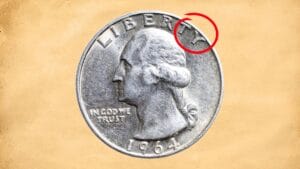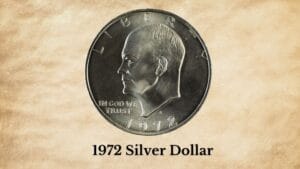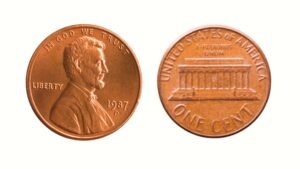The 1964 Washington Quarter holds a significant place in American numismatic history as it marked the end of the era when circulating quarters were composed of 90% silver. Recently, it fetched an impressive $38,000 at auction, highlighting its true value beyond its nominal 25 cents face value.
Designed by John Flanagan and featuring the iconic portrait of George Washington, the 1964 quarter is renowned for its design elegance and historical importance. This article thoroughly explores the composition, design elements, and notable errors that impact a 1964 quarter’s value in today’s collector market.
History of the 1964 Washington Quarter
The Washington Quarter series began in 1932 to celebrate George Washington’s 200th birthday. The 1964 quarter is a highly valuable coin from this series. This coin is special because it is the last Washington quarter, and the traditional silver composition started in 1932.
Due to rocketing prices of silver, President Lyndon Johnson decided to change the Washington quarter coin composition to a copper-nickel clad in 1964. The new, post-1964 quarter coins with the cupro-nickel clad and copper composition lasted for 33 long years with the same obverse and reverse designs.
Finally, In 1999, the traditional Washington quarter was changed to 50 State quarters, known for its unique designs for 50 US states on the reverse.
| 1964 Washington Quarter | Key Facts |
| Coin Composition | 90% silver, 10% copper |
| Minting Location | Philadelphia, Denver |
| Year of Minting | 1964 |
| Weight | 5.67 grams |
| Diameter | 24.26 mm |
| Thickness | 1.75 mm |
| Designer | John Flanagan |
| Face Value | $0.25 (25 cents) |
| Mint Marks | “D” (Denver Mint), no mint mark (Philadelphia Mint) |
| Total Mintage | 560,390,585 (Philadelphia Mint) 704,135,528 (Denver Mint) |
How to Spot a 1964 Washington Quarter (Design & Composition)
You can identify a real 1964 Washington quarter coin with the following design details on the front and back of the coin:
1964 Quarter Obverse (Heads):
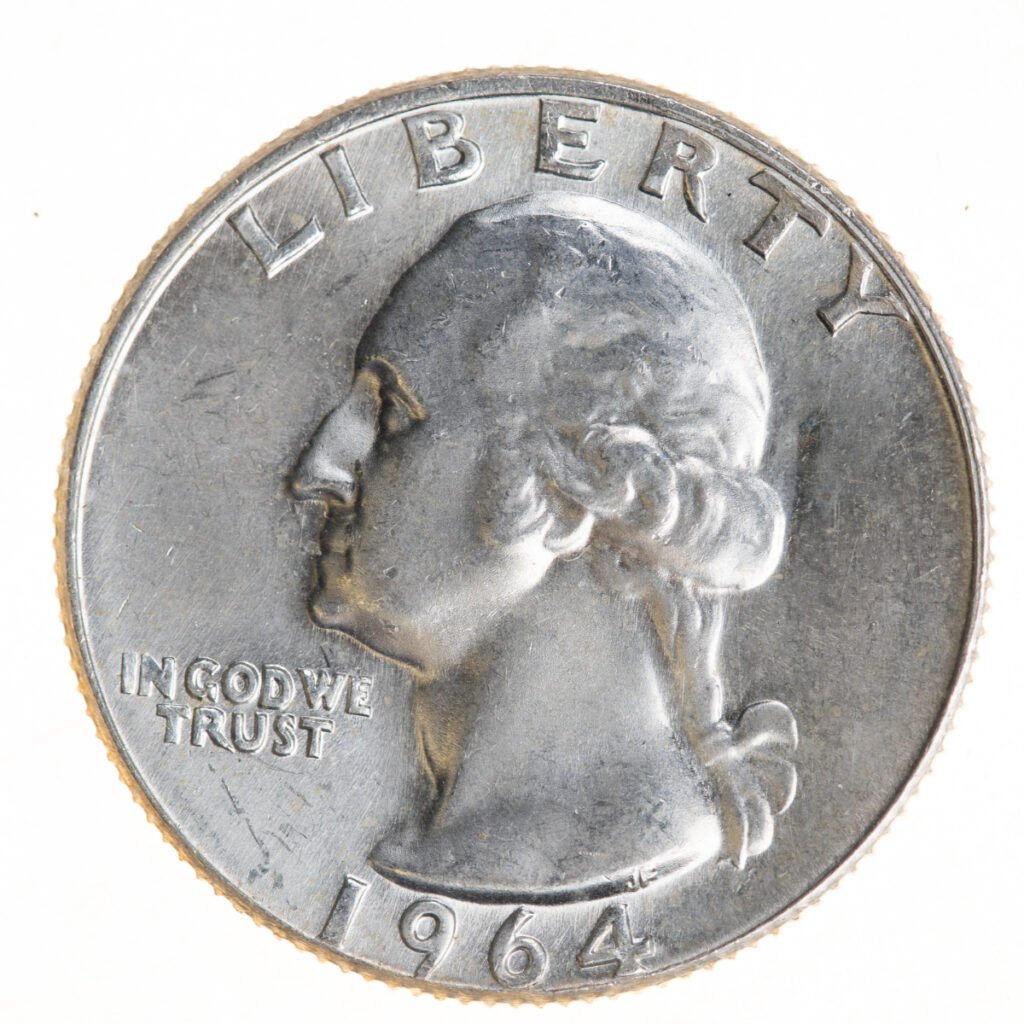
- The left profile of George Washington
- The word “LIBERTY” above Washington’s head
- The mint year “1965” relief carved below the truncation line of the cameo
- The words “IN GOD WE TRUST” in small font on the lower-left side
1964 Quarter Reverse (Tails):

- The words “UNITED STATES OF AMERICA” on the top
- A left-facing eagle with spread-out wings and a bundle of arrows in its claws
- The US motto, “E. PLURIBUS UNUM,” above the eagle’s head in a small font
- Two olive branches tied together below the eagle
- The denomination words “QUARTER DOLLAR” on the bottom
Coin Composition:
The 1964 Washington quarter has the conventional silver coin composition with 90% silver and 10% copper. The composition switched to a copper-nickel clad, which has a 75% copper and 25% nickel layer on a pure copper core, in 1965.
It weighs around 5.67 grams and measures 24.26 mm in diameter. Its original composition and the fact that the 1964 quarter is the last coin of the silver quarter series make this coin more valuable than its face value of 25 cents.
4 Factors to Find the Value of the 1964 Washington Quarter
The average value of a 1964 Washington Quarter is around $1 to $20, with high-grade or rare error coins fetching up to hundreds to a few thousand dollars. Now, this worth depends on a few crucial factors, such as the coin’s condition, rarity, and errors, as explained below.
1. Coin Grade & Condition
The value of an old 1964 quarter coin greatly depends on its condition. The better the condition, the higher the worth. While you can assess the condition based on visible features, like the clarity and sharpness of relief design, patina, etc., it’s recommended to get your coin professionally graded.
Based on our extensive research on sites like eBay, here are the estimated prices of a 1964 Washington Quarter based on its grading & condition:
| 1964 Quarter’s Grading | Estimated Value |
| Poor (0) to Extremely Fine (XF45) | $0 – $10 |
| Almost Uncirculated (AU50) to Mint State (MS 65) | $10 – $50 |
| Mint State (MS65+) | $100 – $3,500 (MS67+) |
| Proof Coins | Up to $1,200 |
2. Rare Mint Errors in the 1964 Washington Quarter
A 1964 quarter with a rare coin error is highly collectible. As of now, around four valuable 1964 quarter mint errors have been discovered:
Double Die Obverse:
The 1964 DDO error quarter coins have a doubled design on the obverse, especially in the letters “In God We Trust.” While regular coins in extremely fine or low-grade mint state condition are worth $100 – $250, high-grade DDO 1964 quarters, such as MS65 or MS67, can sell for $300 to $2,000+.
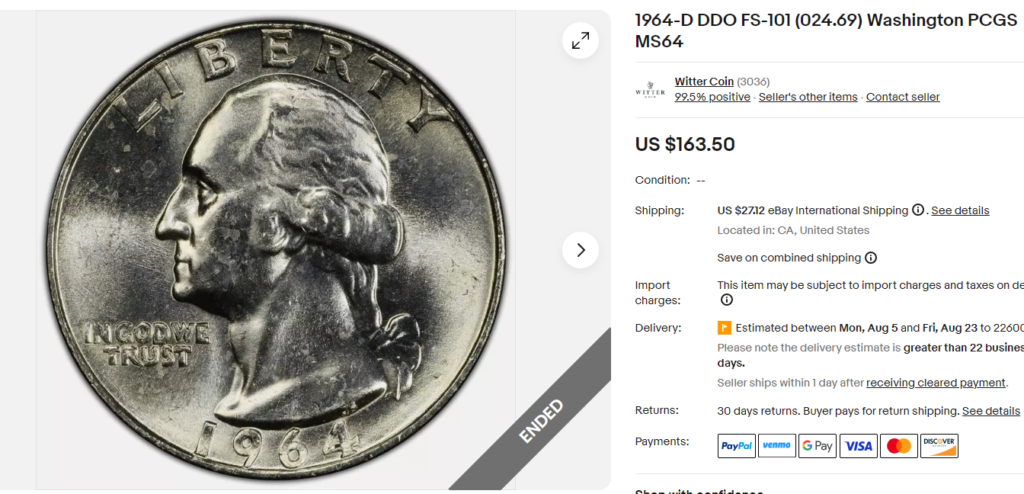
Double Die Reverse:
This error features doubling on the reverse design of the 1964 quarter. In average to fine condition, the 1964 25C DDO Washington quarter is worth around $50 to $150, and in uncirculated condition, it can fetch up to $2,000.
1964-D Quarter with Type C 1965 Reverse:
This unique error features a mismatch between the obverse and reverse of the 1964-D Silver Washington Quarter. This error coin features a 1964 silver quarter obverse paired with a 1965 Clad reverse. The value of the 1964 Type C 1965 reverse error coin is listed at $630 on eBay.
1964 Quarter Type B Reverse:
This error 1964 quarter features the reverse of a proof quarter and the obverse of a regular 1964 silver quarter. Due to its rarity, this coin can sell for up to $500 – $1,000 in mint state, like this 1964 25C Type B Reverse MS66 coin that sold for $700 in an auction on eBay.
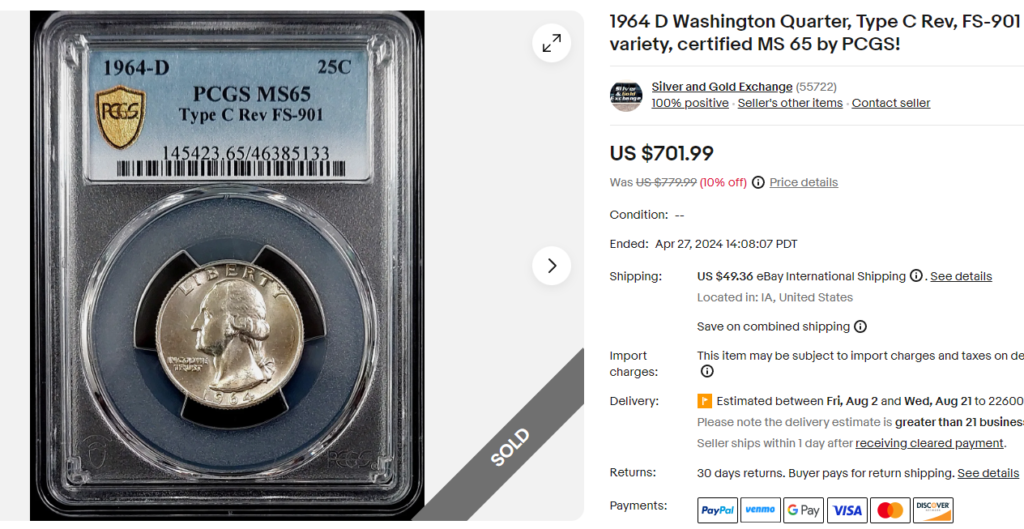
3. Mintage & Rarity
The mintage, or the number of coins produced, plays a significant role in determining the value of your 1964 quarter. In 1964, the Washington quarter was struck in Philadelphia and Denver. Coins minted in Denver have the small D mint mark on the reverse right above the words “QUARTER DOLLAR.”
The Philadelphia Mint (no mint mark) produced 560,390,585 quarters, while the Denver Mint struck 704,135,528 Washington quarters. This high mintage makes 1964 quarters relatively common in circulated grades, which impacts their overall value.
4. Proof Coin & SMS Sets
Like other Washington quarters, a large number of 1964 quarters were also struck in proof and SMS (Special Mint Sets) sets for collectors. These unique quarters are generally more valuable than the regular strike.
1964 Quarter Proof Sets
The 1964 quarter-proof sets are distinguished by their mirror-like finish on the obverse and reverse fields and frosted design elements. These sets were only struck at the Philadelphia Mint and bear no mint mark.
These sets are common in most grades up to PR68 and are worth around $1,000. I found one PR68 coin that sold on Heritage Auctions for $1,150. 1964 quarter PR70 examples are rare and valuable and can fetch an even higher price.
1964 Quarter Special Mint Set
The 1964 Quarter SMS coins were struck at the San Francisco Mint, but they still don’t have a mint mark. These coins have a unique satin-like finish, unlike regular strikes or proofs. Besides, the fields of these rare 1964 quarters are well-struck and clean, with sharp edges and highly detailed features.
Only a few 1964 SMS quarters have been found and sold, making them extremely rare. This makes these coins highly valuable. A high-grade 1964 SMS MS67 quarter sold for $23,000 on Heritage Auctions; generally, they are worth $1,000 – $10,000.
How to Spot a Fake 1964 Washington Quarter
While collecting a rare 1964 quarter, you will surely come across fakes. To spot a fake 1964 quarter, look for the following:
- Check the edge reeding: Count the reeds on the edge of the coin. Genuine 1964 quarters have 119 reeded edges.
- Inspect the date and mint mark placement: Check the mint mark placement. It should be carved between the eagle’s claw and the words “QUARTER DOLLAR” on the reverse.
- Verify the silver composition by weight: Check the coin’s weight. Real 1964 Washington quarters will be heavier than the fake ones due to their 90% silver composition.
- Check the appearance: Fake quarters generally have uneven, distorted, and bad shapes of the digits and numerals in the date on the coin.
Due to its historical significance, the 1964 Washington quarter is a highly collectible coin today. So, whether you want to add it to your old coins collection or sell it, this guide will offer insights to help you assess its true worth.
However, despite being the last silver quarter, it is not the only collectible coin of its kind. Coins from later years, such as the 1965 quarter, 1967 quarter, and 1970 quarters, also hold value and intrigue for collectors. Learn about these quarters in my other detailed guides.
Note: This article is intended for informational, educational, and entertainment purposes only. Some images are illustrative and may not represent actual brands, products, or related entities. All trademarks, product names, brand logos, packaging, and other intellectual property referenced remain the exclusive property of their respective owners. Any brand mentions or references are provided solely for descriptive and educational context and do not imply any formal or commercial association.

